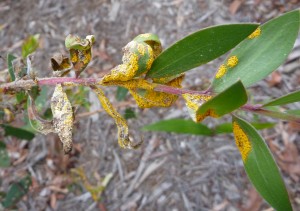Myrtle Rust – now in Australia to stay, but at what environmental cost?
Becky and I attended a workshop hosted by the Glenelg Hopkins CMA and DPI in Hamilton last week about Myrtle Rust.
Normally the NGT Blog is a place reserved for positive messages about things that are happening in the region, but it was hard to come away from the workshop last week without feeling a little bit overwhelmed. You see, myrtle rust is a fungal pathogen of South American origin that attacks new growth on most species within the Myrtaceae family, which includes a huge number of species that comprise dominant vegetation communities in Australian ecosystems (such as Eucalypts, bottle-brushes, paperbarks and tea-trees just for starters). On the most susceptible species, this may lead to a slow but eventual death of entire populations – including the possibility of some species being driven to extinction (particularly in humid east coast habitats).
Over the last couple of years since its detection in Queensland, it has been spread (through a range of means – unfortunately often assisted in travelling huge distances by human movements and trading of plant materials) along the east coast, where the humidity and temperatures are conducive to the rust establishing and spreading in natural bushland as well as public and private gardens and nursuries. The artificially humid conditions maintained year-round through watering in plant production and retail nurseries make them a particularly high risk for promoting (and then spreading) the fungus, and hence the need for the targeted education message of the workshop last week.
Myrtle rust has now reached Melbourne and Ballarat, and it appears to be a matter of time before it reaches the western districts and South Australia. It is currently thought that our hot dry (low humidity) summers may limit the damage the pathogen will have in natural bushland in this region, but we won’t really know for sure until it arrives – and of concern we have plenty of naturally humid ecosystems such as watercourses and tea-tree dominated swamps. For more information about the management approach to myrtle rust in Victoria, please see this site.
This whole issue has got me thinking about biosecurity and how difficult it is to get it right when the odds are stacked against us by the massive scale of modern travel and global trade – and the demand for such long and rapid movements by our current economic model. We have a very long list of species of pathogens, pests and weeds that are of the highest risk to Australia, and quarantine processes that are often cited as being the best in the world. Yet the very nature of these species are such (being so invasive) that by the time an incursion has been noticed, eradication is often impossible – as is the case with myrtle rust. And with the sheer volume of traffic today, the incursions will keep happening….
While many people quite rightly lament the loss of human cultural diversity as a result of globalisation, the ever increasing global traffic in people and goods, is leading to a slow but inevitable homogenisation of global ecosystems in a process driven by chance. Something us nature lovers are not really prepared for, but reality never-the-less.
To illustrate why this issue is so difficult – consider this: we were told last week that the sticky spores of myrtle rust can remain viable for up to 5 days when not on host-plant material. It is thought that myrtle rust most likely arrived in Queensland by being brought on the backpack of an international traveler who went to work on the cut-flower farm where it was first detected. This very type of travel is happening thousands of times ever year and the chances of any one of those people carrying a pathogen are very slim – but as we know, it only takes one…


